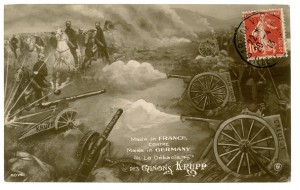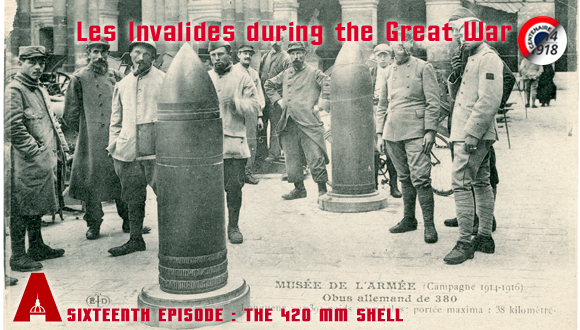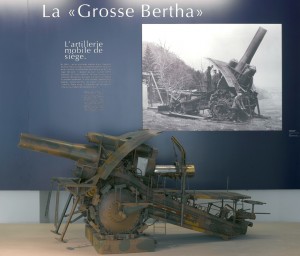 On that day, the main courtyard is open to the public. Civilians and military come to see the trophies installed in 1915.
On that day, the main courtyard is open to the public. Civilians and military come to see the trophies installed in 1915.
Unexploded 420 mm shell
The photograph shows the public’s curiosity for the impressive shell 1.54 metres high, much bigger than some of the children around it. The position of the man seen from the back in the foreground seems to express astonishment at this steel monster. Another attraction: the camera belonging to the operator who took the photo, attracts the attention of the small boy who, hidden behind the shell, peers around it to see better, and also that of the man wearing a beret who holds his hands crossed in front of him as if he didn’t know what to do with them, or again the woman who, on the extreme right, her hands on her hips, turns her head towards the lens, narrowing her eyes, bothered by the bright light which makes the tip of the 420 mm shell shine.
“Big Bertha”
The Germans were particularly associated with the development of heavy artillery during the First World War. Without any doubt, Big Bertha – in German Dicke Bertha – was one of their most famous pieces of artillery which fired 420 mm shells, similar to the one in this photograph. The howitzer’s real name was in fact Kurze-Marine-Kanone 14 in its M42 version. According to some people, its nickname comes from a custom in the Krupp companies: to name the new guns they manufactured after a member of the family, in this case Bertha Krupp, the group’s sole heiress!
was one of their most famous pieces of artillery which fired 420 mm shells, similar to the one in this photograph. The howitzer’s real name was in fact Kurze-Marine-Kanone 14 in its M42 version. According to some people, its nickname comes from a custom in the Krupp companies: to name the new guns they manufactured after a member of the family, in this case Bertha Krupp, the group’s sole heiress!
At the end of the war, the German army destroyed all the 420 mm howitzers to avoid them falling into the hand of the Allies. There is only a model and a German photograph of Big Bertha in the permanent exhibition rooms on the First World War in the Musée de l’Armée.



Ajouter un commentaire